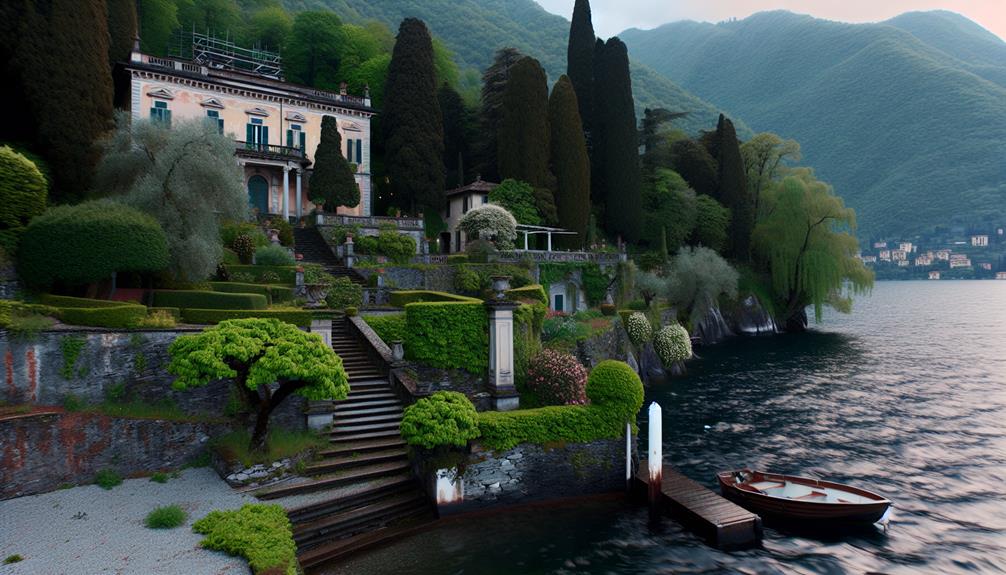Lake Como’s famous villas and gardens are steeped in history, each telling stories of Italian nobility, artistic movements, and architectural grandeur. From centuries-old estates to beautifully preserved gardens, these landmarks offer a fascinating journey through time. If you’re planning a visit, explore our guide to Italy Lake Como villas and find accommodations that allow you to fully immerse yourself in the lake’s historical charm.
As you explore the shores of Lake Como, you’ll discover a collection of villas and gardens that seem frozen in time. These stunning estates, with their intricate stonework and lush landscapes, have been the summer retreats of royalty and aristocrats for centuries. But what’s behind the grand facades and perfectly manicured gardens? You’ll find that each villa has a unique story to tell, shaped by the notable figures who once called them home. By tracing the history of these villas, you’ll uncover a rich tapestry of architectural grandeur and cultural significance that’s waiting to be explored further.

History of Lake Como Villas
You step into the tranquil world of Lake Como’s famous villas, and it’s easy to get lost in their majestic beauty. These stunning structures have a rich history that dates back to the Roman era. The villas were initially built as summer residences for wealthy Romans, who sought to escape the heat and chaos of city life.
As the centuries passed, the villas evolved to reflect the changing architectural styles and tastes of their owners. In the 16th century, the villas underwent a transformation, with the addition of beautiful gardens and ornate decorations. The Renaissance period saw the construction of grand estates, such as Villa Carlotta and Villa Balbianello, which boasted stunning architecture and breathtaking views of the lake.
Famous Villa Owners and Residents
The opulent villas that line Lake Como’s shores have been home to a long list of notable owners and residents throughout history. As you explore the villas, you’ll discover the rich history of those who once called them home.
Villa Carlotta, for instance, was once the residence of Princess Marianne of Nassau, the daughter of the Grand Duke of Luxembourg. The villa was a gift to her from her mother and became a haven for the princess and her family.
Other notable residents include Giovanni Battista Giovio, the 16th-century historian and bishop who built the stunning Villa Giovio in Brunate. The villa was later purchased by the German noble family, the Oesterreichs, who hosted numerous high-profile guests, including Emperor Franz Joseph I of Austria.
You’ll also find the beautiful Villa Serbelloni, which was once the summer residence of the powerful Serbelloni family and later became a popular destination for the likes of Napoleon Bonaparte and Queen Victoria.
Each villa has its own unique story to tell, filled with the history and intrigue of its former owners and residents.
Preservation and Restoration Efforts
Many of Lake Como’s iconic villas have undergone significant preservation and restoration efforts over the years to maintain their historic charm and grandeur.
You’ll notice the meticulous attention to detail as you stroll through the gardens and villas, a representation of the dedication of local authorities, private owners, and international organizations working together to preserve these cultural treasures.
Restoration projects often involve extensive research and planning to guarantee that the original architecture and design are respected and maintained.
You’ll see evidence of this in the carefully restored frescoes, ornate plasterwork, and intricate stone carvings that adorn the villas’ facades and interiors.
Additionally, efforts are made to preserve the original plant species and garden designs, which not only add to the villas’ aesthetic appeal but also provide valuable insights into the region’s horticultural history.
Thanks to these preservation and restoration efforts, you can now experience the beauty and majesty of Lake Como’s villas and gardens much as they were originally intended.
As you explore these magnificent properties, you’ll gain a deeper appreciation for the region’s rich cultural heritage and the importance of preserving it for future generations.